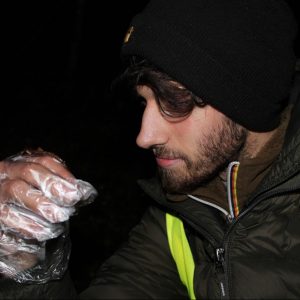Proteidae
This family is represented by 2 genera, the Proteus in Europe and Necturus in North America. Both genus are characterised by aquatic, paedomorphic salamanders with large external gills and laterally compressed tail fins.
So far, only one species of Proteus is recognised, while Necturus is represented by 5 species.
The only species of the Proteidae genus is the Olm, or European blind cave salamander (Proteus anguinus). This salamander is characterised by reduced eyes and their troglobite lifestyle. Due to his habitat, sighting of this salamander were rare, and often limited to animals washed up to the surface from their caves. Due to their aspect, they were often described as baby dragons.
The most notorious subspecies is the White Olm (Proteus anguinus anguinus) which is characterized by eyes hidden under the skin of the head, and a white/translucent skin, which can turn blackish if exposed to light. There have been attempts in dividing the populations in multiple species and subspecies. While all population are fairly similar, allozyme studies point as some differences, due to populations being separated during the Miocene (5-6 million years ago). Despite these genetic, as well as morphological, differences no further subspecies of white olm are recognised, as these differences are still within the variation range of the sub specie.
In 1986 a new subspecies of Olm (Proteus anguinus parkeji) was discovered in underground waters near Črnomelj, Slovenia, an area smaller than 100 square kilometres and it was formally described in 1994 by Sket & Arntzen. The peculiarity of this subspecies is that it has developed eyes, although small, several physical differences and retained pigmentation, earning the name of Black Olm.
The Necturus is a North American genus that has normal pigmentation and eyes, the adults are large and robust salamander with four toes on each of their feet. Members of this family are commonly called “mudpuppies” or “waterdogs” (which is shared sometimes with Ambystomidae larvae) due to the wrong belief that are able to bark. Their natural habitat is streams, rivers, and lakes, where they remain under rocks and in between debris during the day, to hunt at night. Hatchlings and juveniles use rocks and other objects for shelter, Necturus of all ages use burrows of crayfish and other animals in underwater stream banks. Both sexes actively defend their burrows. Waterdogs are inactive during hot summer periods, when invertebrate prey are scarce, and are most active during colder months, in particular after moderate rains.
Adults and juveniles eat almost any animals that they can capture and swallow, which usually includes many types of invertebrates like insects, spiders, and crustacea, but also small fishes. There are also some documented cases of predation on small snakes and turtles.
Courtship and mating have not been described for all of the species of this genus(for example for Necturus punctatus). Mating usually occurs from late fall through winter with egg deposition in spring. Females attach about 4-5 to 40-50 eggs (with exception of Necturus maculosus, which can reach 200-250 eggs for each female) to the underside of logs, rocks and other objects on the stream bottom.
Predators of Necturus include crayfish, predatory fish, carnivorous turtles, watersnakes(like Nerodia sipedon), herons, otters, and larger Necturus. Skin secretions may deter some predators
The Proteidae are members of the Suborder Salamandroidea, that includes all internally-fertilising salamanders. Parental care has been observed, with either the male or female attending the eggs until hatching.
Despite the similarities between the genera of the group, the grouping of Necturus and Proteus under the same family is controversial as current analysis may suggest that Necturus, together with Ambystomatidae, Dicamptodontidae and Salamandridae form a monophyletic group, meaning they had a recent common ancestor, but it is not clear if Proteus fells under the same group. The shared features of the two genus therefore may result as parallel, paedomorphic evolutionary trends and not a strong indication of common ancestry
Species List
Genus Necturus (5 species)
Necturus alabamensis
Necturus lewisi
Necturus maculosus
Necturus beyeri
Necturus punctatus
Genus Proteus (1 species)
Proteus anguinus
In Collaboration with....

References
Citation: Grosse, W.-R. (2018). Threatened Newts and Salamanders – Captive Care Management Vol.2. Martensiella.
Citation: Mitchell, J. C., & Gibbons, J. W. (2010). Salamanders of the Southeast. Athens: University of Georgia Press.
Citation: Heying, H. 2003. “Proteidae” (On-line), Animal Diversity Web. Accessed February 04, 2019 at https://animaldiversity.org/accounts/Proteidae/
Citation: AmphibiaWeb: Information on amphibian biology and conservation. [web application]. 2018. Berkeley, California: AmphibiaWeb. Available: https://amphibiaweb.org/. (Accessed: 2019).
Citation:Larson, Allan. 2006. Proteidae. Mudpuppies, waterdogs. Version 23 August 2006 (under construction). http://tolweb.org/Proteidae/15449/2006.08.23 in The Tree of Life Web Project, http://tolweb.org/
Citation: Sket, B., & Arntzen, J. W. (1994). A black, non-troglomorphic amphibian from the karst of Slovenia: Proteus anguinus parkelj n. ssp.(Urodela: Proteidae). Bijdragen tot de Dierkunde, 64(1), 33-53.
![Proteus Anguinus Head by Arne Hodalič [CC BY-SA 3.0], via Wikimedia Commons](https://sp-ao.shortpixel.ai/client/to_auto,q_glossy,ret_img,w_300,h_206/https://salamanderland.com/wp-content/uploads/2019/08/P_anguinus-head1.jpg)
![Proteus anguinus parkelj head by Arne Hodalič [CC BY-SA 3.0], via Wikimedia Commons](https://sp-ao.shortpixel.ai/client/to_auto,q_glossy,ret_img,w_300,h_196/https://salamanderland.com/wp-content/uploads/2019/08/P_anguinus_parkelj-head.jpg)